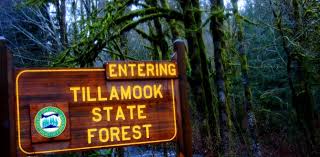The Oregon Department of Forestry released a report to state forest trust land counties highlighting social, economic and environmental accomplishments in fiscal year 2022, including distributing $30.5 million to Tillamook, Washington and Columbia counties along with local service providers.
At over 357,000 acres, the Tillamook State Forest is Oregon’s largest state forest. Tillamook County and local taxing districts with state forestland received $14.9 million in fiscal year 2022, while Washington County and local districts received $13.3 million. Additionally, a portion of state forestland in Columbia County managed out of ODF’s Forest Grove District generated $2.2 million for the county. In addition to county governments, some revenue flows to local service providers such as schools, rural fire districts, recreation and transportation districts, and other public agencies Oregonians use and value.
ODF recently released its Council of Forest Trust Land Counties annual report, which highlights the array of social, economic and environmental contributions from approximately 729,000 acres of actively managed state forestland. It includes a recap of timber sales and revenue distribution, conservation and forest health activities, and recreation use, including popularity and number of visitors, among other statistics.
Statewide, counties and local governments received revenues of $61.8 million in fiscal year 2022, collected from timber sales on state-owned forests. Revenues are distributed based on timber sales within a particular jurisdiction. Other highlights include replanting more than 3.6 million trees, hosting more than 26,000 campers at ODF campgrounds, and maintaining hundreds of miles of motorized and non-motorized trails.
Counties and local service providers receive approximately 64 percent of net revenues from timber harvests on state forests. The remaining revenues finance most aspects of state forest management, including ODF’s recreational offerings, environmental enhancement projects, replanting after timber harvest, and forest road maintenance. The state’s share of revenue was approximately $35.5 million in fiscal year 2022. The agency also receives a portion of all-terrain vehicle operating permit fees.
“Oregonians have a lot to be proud of when it comes to their state forestlands,” State Forester Cal Mukumoto said. “These working lands provide so much to so many, including funding for vital local services, places to connect with nature, clean water, and habitat for some of Oregon’s most rare and sensitive species.”
On the Tillamook State Forest, one environmental highlight included replacing a failing culvert on Whitney Creek with a bridge. The new bridge reinforces the connection to the Kilchis River, restoring fish passage and reconnected natural stream sediment transport processes.
State forests managed by the Oregon Department of Forestry are distributed across 15 counties, with the largest being the Clatsop (generated $19.1 revenue) and Tillamook state forests on the north coast, the Santiam State Forest ($6.7 million revenue) in the northern Cascade Range, and the Gilchrist and Sun Pass state forests in Klamath County. Other scattered tracts can be found throughout western Oregon (generated $2 million revenue.) Many State Forests employees also are part of Oregon’s complete and coordinated fire protection system, providing critical resources and expertise during fire season.


